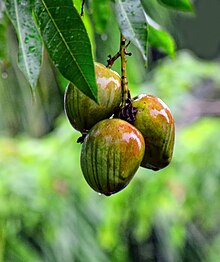Mangoes
| Mango | |
|---|---|
 |
|
| Fruit | |
| Scientific classification | |
| Kingdom: | Plantae |
| (unranked): | Angiosperms |
| (unranked): | Eudicots |
| (unranked): | Rosids |
| Order: | Sapindales |
| Family: | Anacardiaceae |
| Genus: | Mangifera |
| Species: | M. indica |
| Binomial name | |
|
Mangifera indica L. |
|
| Synonyms | |
| Nutritional value per 100 g (3.5 oz) | |
|---|---|
| Energy | 250 kJ (60 kcal) |
|
15 g
|
|
| Sugars | 13.7 |
| Dietary fiber | 1.6 g |
|
0.38 g
|
|
|
0.82 g
|
|
| Vitamins | |
| Vitamin A equiv. |
(7%)
54 μg
(6%)
640 μg23 μg
|
| Thiamine (B1) |
(2%)
0.028 mg |
| Riboflavin (B2) |
(3%)
0.038 mg |
| Niacin (B3) |
(4%)
0.669 mg |
| Pantothenic acid (B5) |
(4%)
0.197 mg |
| Vitamin B6 |
(9%)
0.119 mg |
| Folate (B9) |
(11%)
43 μg |
| Choline |
(2%)
7.6 mg |
| Vitamin C |
(44%)
36.4 mg |
| Vitamin E |
(6%)
0.9 mg |
| Vitamin K |
(4%)
4.2 μg |
| Minerals | |
| Calcium |
(1%)
11 mg |
| Iron |
(1%)
0.16 mg |
| Magnesium |
(3%)
10 mg |
| Manganese |
(3%)
0.063 mg |
| Phosphorus |
(2%)
14 mg |
| Potassium |
(4%)
168 mg |
| Sodium |
(0%)
1 mg |
| Zinc |
(1%)
0.09 mg |
|
|
|
|
|
| Percentages are roughly approximated using US recommendations for adults. Source: USDA Nutrient Database |
|
Mangifera austro-yunnanensis Hu
The mango is a juicy stone fruit (drupe) belonging to the genus Mangifera, consisting of numerous tropical fruiting trees, cultivated mostly for edible fruit. The majority of these species are found in nature as wild mangoes. They all belong to the flowering plant family Anacardiaceae. The mango is native to South Asia, from where it has been distributed worldwide to become one of the most cultivated fruits in the tropics.
While other Mangifera species (e.g. horse mango, Mangifera foetida) are also grown on a more localized basis, Mangifera indica—the "common mango" or "Indian mango"—is the only mango tree commonly cultivated in many tropical and subtropical regions.
It is the national fruit of India, Pakistan, and the Philippines, and the national tree of Bangladesh.
Mango trees grow to 35–40 m (115–131 ft) tall, with a crown radius of 10 m (33 ft). The trees are long-lived, as some specimens still fruit after 300 years. In deep soil, the taproot descends to a depth of 6 m (20 ft), with profuse, wide-spreading feeder roots; the tree also sends down many anchor roots, which penetrate several feet of soil. The leaves are evergreen, alternate, simple, 15–35 cm (5.9–13.8 in) long, and 6–16 cm (2.4–6.3 in) broad; when the leaves are young they are orange-pink, rapidly changing to a dark, glossy red, then dark green as they mature. The flowers are produced in terminal panicles 10–40 cm (3.9–15.7 in) long; each flower is small and white with five petals 5–10 mm (0.20–0.39 in) long, with a mild, sweet odor suggestive of lily of the valley. Over 400 varieties of mangoes are known, many of which ripen in summer, while some give double crop. The fruit takes three to six months to ripen.
...
Wikipedia
